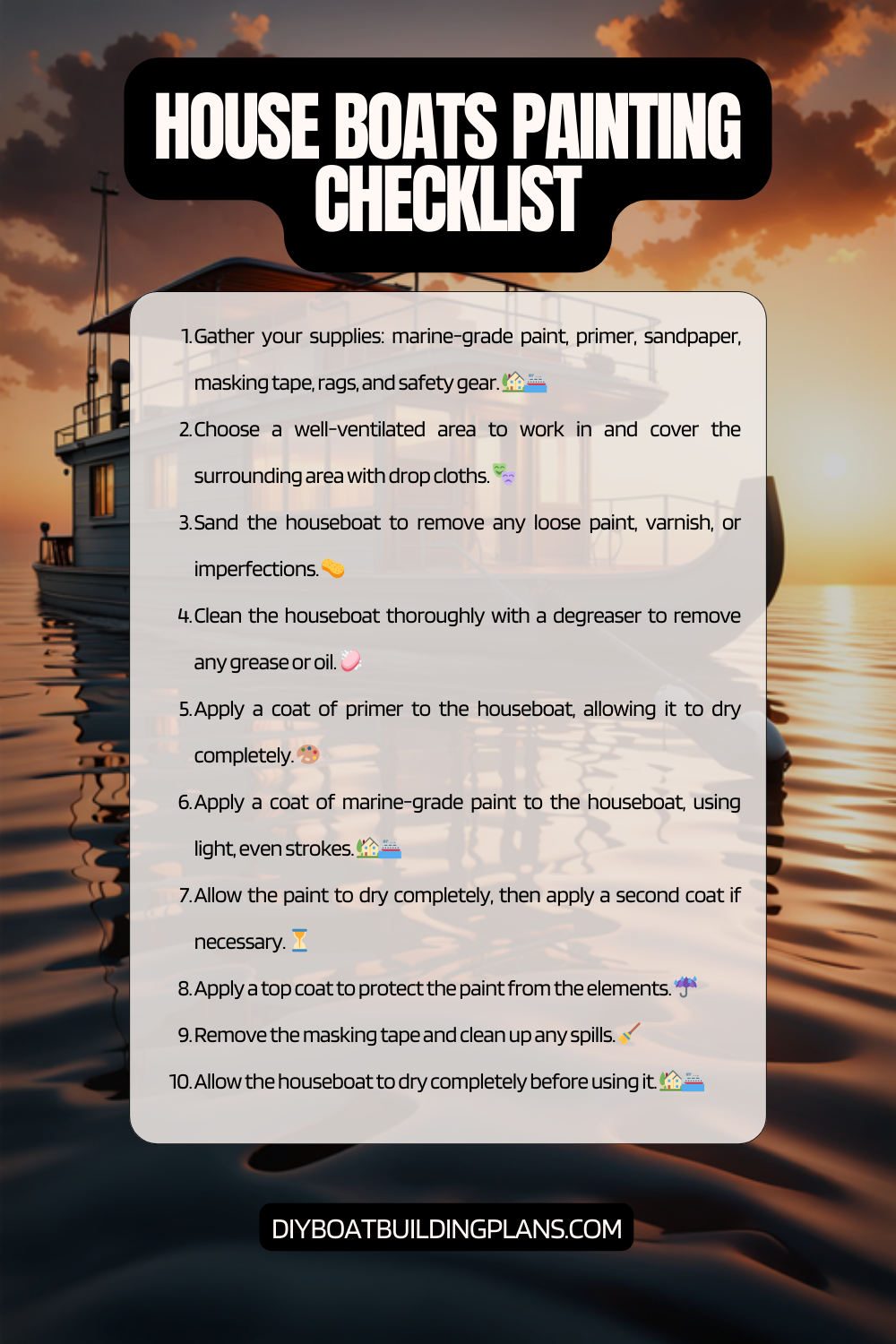Overview of House Boat Painting Tips
Painting a house boat is an essential part of its maintenance and upkeep. Not only does it enhance the aesthetic appeal of the boat, but it also protects it from the harsh elements of the water. In this comprehensive guide, we will explore everything you need to know about house boat painting, from choosing the right paint to maintaining the paint job. Whether you are a seasoned boat owner or a first-time painter, this article will provide you with valuable insights and tips to ensure a successful painting project.
Key Takeaways
- Choose the right paint for your house boat based on the material and environment.
- Properly prepare your house boat for painting by cleaning and sanding the surface.
- Essential tools and materials for house boat painting include brushes, rollers, paint trays, and masking tape.
- When painting the exterior of your house boat, work in small sections and apply multiple coats for best results.
- To maintain your house boat paint job, regularly clean and wax the surface and touch up any chips or scratches.

Choosing the Right Paint for Your House Boat
Selecting the appropriate paint for your house boat is crucial for achieving a long-lasting and durable finish. There are several types of paint suitable for house boats, including marine-grade paints, epoxy coatings, and polyurethane paints. Marine-grade paints are specifically formulated to withstand the harsh conditions of water, providing excellent resistance to fading, chipping, and peeling. Epoxy coatings offer superior adhesion and durability, making them ideal for high-traffic areas such as decks and hulls. Polyurethane paints provide a glossy finish and excellent UV resistance.
When choosing paint for your house boat, consider factors such as the type of material your boat is made of, the intended use of the painted surface, and your budget. It is also essential to select a paint that is compatible with any existing coatings on your boat. Some recommended brands for house boat painting include Interlux, Pettit, and Awlgrip. These brands have established a reputation for producing high-quality marine paints that deliver exceptional results.
Preparing Your House Boat for Painting
Proper preparation is key to achieving a flawless paint job on your house boat. Before you begin painting, thoroughly clean the boat to remove any dirt, grime, or salt residue that may interfere with paint adhesion. Use a mild detergent and water solution or specialized boat cleaning products to ensure a clean surface. After cleaning, sand the boat’s surface to create a smooth and even texture. This step helps the paint adhere better and ensures a professional-looking finish.
Inspect your boat for any damages, such as cracks, chips, or dents. Repair these areas before painting to prevent further deterioration and to achieve a seamless appearance. Depending on the extent of the damage, you may need to use epoxy fillers or fiberglass patches. Once the repairs are complete, apply a primer to the boat’s surface. Primers improve paint adhesion and provide an additional layer of protection against moisture and corrosion.
Essential Tools and Materials for House Boat Painting
| Tool/Material | Description |
| Pressure Washer | A high-pressure water sprayer used to remove dirt, grime, and loose paint from the boat’s surface. |
| Sandpaper | Abrasive paper used to smooth out rough surfaces and remove old paint before applying a new coat. |
| Paint Scraper | A tool used to remove loose paint and other debris from the boat’s surface. |
| Paint Brushes | Various sizes of brushes used to apply paint to the boat’s surface. |
| Rollers | Used to apply paint to large areas of the boat’s surface quickly and evenly. |
| Paint Sprayer | A tool used to apply paint to large areas of the boat’s surface quickly and evenly. |
| Primer | A preparatory coating applied to the boat’s surface before painting to ensure better adhesion and durability of the paint. |
| Paint | A coating applied to the boat’s surface to protect it from the elements and give it a fresh, new look. |
| Protective Gear | Includes gloves, goggles, and respirators to protect the painter from harmful chemicals and fumes. |
To successfully paint your house boat, you will need a range of tools and materials. Some essential tools include paintbrushes, rollers, paint sprayers, sandpaper, masking tape, drop cloths, and mixing containers. Paintbrushes come in various sizes and types, such as bristle brushes for oil-based paints and synthetic brushes for water-based paints. Rollers are ideal for large surfaces, while paint sprayers offer a faster and more even application.
Materials required for house boat painting include paint, primer, thinners or solvents (if necessary), cleaning products, and protective gear such as gloves and goggles. It is crucial to choose high-quality tools and materials to ensure a professional finish that will withstand the harsh marine environment.
Tips for Painting the Exterior of Your House Boat
Painting the exterior of your house boat requires careful planning and execution. Follow these step-by-step guidelines to achieve a smooth and long-lasting finish:
1. Prepare the surface: Clean the boat thoroughly, sand any rough areas, repair damages, and apply primer.
2. Choose the right weather: Ideally, paint your boat on a dry day with moderate temperatures. Avoid painting in extreme heat or cold as it can affect paint adhesion and drying time.
3. Use the right technique: Start by cutting in the edges with a brush, then use a roller or sprayer for larger areas. Apply thin coats of paint, allowing each coat to dry before applying the next.
4. Pay attention to drying time: Follow the manufacturer’s instructions regarding drying time between coats. Avoid rushing the process as it can lead to poor adhesion and a less durable finish.
5. Protect the surrounding areas: Use masking tape and drop cloths to protect windows, hardware, and other areas that should not be painted.
6. Apply multiple coats: Depending on the type of paint and desired finish, you may need to apply multiple coats for optimal coverage and durability.
Tips for Painting the Interior of Your House Boat
Painting the interior of your house boat requires some additional considerations due to limited space and unique challenges. Follow these tips for a successful interior paint job:
1. Choose light colors: Lighter colors can make small spaces appear larger and create a more open and airy feel. Consider using white or pastel shades for a fresh and inviting interior.
2. Opt for low-VOC paints: Volatile Organic Compounds (VOCs) can release harmful fumes into the confined space of your boat. Choose low-VOC or zero-VOC paints to ensure a healthier environment.
3. Plan your painting sequence: Start with the ceiling, then move on to walls, doors, and trim. This sequence allows for easier access and minimizes the risk of smudging or damaging freshly painted surfaces.
4. Use small brushes and rollers: Due to limited space, use smaller brushes and rollers that can navigate tight corners and edges more easily.
5. Allow for proper ventilation: Ensure proper ventilation during the painting process by opening windows or using fans to circulate air. This helps speed up drying time and prevents the buildup of fumes.
Common Mistakes to Avoid When Painting Your House Boat
While painting your house boat, it is essential to be aware of common mistakes that can compromise the quality and longevity of your paint job. Here are some mistakes to avoid:
1. Skipping the preparation process: Neglecting proper cleaning, sanding, and priming can lead to poor paint adhesion and premature peeling or chipping.
2. Using the wrong type of paint: Using interior paint on the exterior or vice versa can result in a finish that is not suitable for the harsh marine environment.
3. Applying too thick or too thin coats: Applying paint too thickly can lead to drips and uneven coverage, while applying it too thinly may result in poor durability and inadequate protection.
4. Ignoring weather conditions: Painting in extreme temperatures, high humidity, or windy conditions can affect paint drying time and adhesion. Choose a suitable day for painting and follow the manufacturer’s recommendations.
5. Rushing the process: Patience is key when painting a house boat. Rushing through the process can lead to mistakes, uneven coverage, and a less professional finish.
Maintaining Your House Boat Paint Job
To ensure the longevity of your house boat’s paint job, regular maintenance is essential. Here are some tips for maintaining your boat’s appearance:
1. Clean regularly: Wash your boat regularly with mild detergent and water to remove dirt, salt residue, and other contaminants that can degrade the paint.
2. Avoid abrasive cleaners: Use gentle cleaning products specifically designed for boats to avoid damaging the paint finish.
3. Wax periodically: Apply a high-quality marine wax to protect the paint from UV rays, saltwater, and other environmental factors. Waxing also helps maintain a glossy finish.
4. Inspect for damages: Regularly inspect your boat for any signs of chipping, peeling, or cracking. Address these issues promptly to prevent further damage.
5. Repaint when necessary: Depending on the type of paint and the level of wear and tear, you may need to repaint your boat every few years. Follow the manufacturer’s recommendations for repainting intervals.
Hiring a Professional House Boat Painter
While painting your house boat can be a rewarding DIY project, there are instances where hiring a professional painter is the best option. Consider the following factors when deciding whether to hire a professional:
1. Time and expertise: Painting a house boat requires time, skill, and knowledge of marine-grade paints and techniques. If you lack the necessary experience or have limited time, hiring a professional can ensure a high-quality result.
2. Safety considerations: Painting a boat involves working at heights, handling potentially hazardous materials, and navigating tight spaces. If you are not comfortable with these aspects or lack the necessary safety equipment, it is advisable to hire a professional.
3. Complex repairs: If your boat requires extensive repairs before painting, a professional painter may have the expertise to handle these tasks effectively.
When hiring a professional house boat painter, research reputable companies or individuals with experience in marine painting. Ask for references, view their portfolio, and inquire about their certifications and insurance coverage. Additionally, request a detailed estimate that includes all costs associated with the project.
Download over 500 Boat Plans. Click on the link below.
-->Click Here<--
House Boat Painting Checklist

Conclusion – House Boat Painting Tips
Painting a house boat is a significant undertaking that requires careful planning, preparation, and execution. By choosing the right paint, properly preparing the boat’s surface, using the appropriate tools and techniques, and avoiding common mistakes, you can achieve a professional-looking finish that will protect your boat for years to come. Whether you decide to tackle the project yourself or hire a professional painter, following the tips and guidelines outlined in this article will help you achieve outstanding results. Remember to prioritize regular maintenance to ensure the longevity of your house boat’s paint job.
FAQs – House Boat Painting Tips
What is a house boat?
A house boat is a type of boat that is designed to be used primarily as a home. It typically has living quarters, a kitchen, and bathroom facilities.
Why do house boats need to be painted?
House boats need to be painted to protect the exterior from the elements, such as sun, wind, and water. Painting also helps to maintain the appearance of the boat.
What are some tips for painting a house boat?
Some tips for painting a house boat include choosing the right type of paint, preparing the surface properly, using the right tools, and applying the paint in thin, even coats.
What type of paint should be used for a house boat?
The type of paint that should be used for a house boat depends on the material of the boat’s exterior. For example, fiberglass boats require a different type of paint than aluminum boats.
How should the surface of a house boat be prepared before painting?
The surface of a house boat should be cleaned and sanded before painting. Any cracks or holes should be filled with putty or epoxy, and the surface should be primed before painting.
What tools are needed for painting a house boat?
Tools needed for painting a house boat include paint brushes, rollers, paint trays, sandpaper, putty knives, and masking tape.
How many coats of paint should be applied to a house boat?
Typically, two to three coats of paint are needed to properly cover a house boat. However, the number of coats needed may vary depending on the type of paint and the condition of the boat’s exterior.



